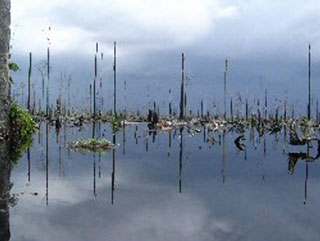Is Indonesia the third largest greenhouse gas polluter?
Is Indonesia the third largest greenhouse gas polluter?
Burning of peatlands fuels global warming according to new report
mongabay.com
November 3, 2006
Is Indonesia the world’s third largest producer of greenhouse gases? A new study by Wetlands International says it is, if the country’s destruction of peat bogs is taken into account.
A report released Thursday by Wetlands International and Delft Hydraulics, a Dutch research institute, estimates that emissions from Indonesia’s destruction of its extensive peat bogs releases 2 billion tonnes of carbon dioxide a year — about ten percent of world greenhouse gas emissions from human activities. For comparison, the United States, the world’s largest emitter of heat-trapping gases, produces about 7.3 billion tons of greenhouse gases per year.
70 percent of emissions result from the burning of peatlands, while 30 percent result from drainage, according to the report, titled Peatland degradation fuels climate change.
Peatlands in Indonesia
Peatlands, formed by organic deposits comprised of partially decayed plant matter that accumulates over time, cover more than 400 million hectares of land worldwide. Most of these exist in permafrost in the far north, though some are found in the lowlands of tropical Asia, especially in the swampy forests of Indonesia and Malaysia.
Peatlands, formed over hundreds of years and sometimes more than 66 feet (20 meters) deep, are giant reservoirs of carbon, storing around 2,000,000 million tons of carbon dioxide globally. However, when peatlands are drained, cut, or burned this stored carbon is released into the atmosphere, contributing to climate warming.
 Destroyed peat swamp forest in Indonesia. Image courtesy of Wetlands International. The report estimates that production of one metric ton of palm oil will result in an average emission of 20 tonnes of carbon dioxide from peat decomposition alone, not including emissions resulting from production or combustion. |
Each year hundreds of thousands of hectares of peatlands are drained and cleared for oil palm and timber plantations. Generally, developers dig a canal to drain the land, extract valuable timber, then clear the vegetation using fire. In dry years these fires can burn for months, contributing to the “haze” that plagues southeast Asian on a regular basis. Fires in peatlands are especially persistent, since they can continue to smolder underground for years even after surface fires on extinguished by monsoon rains.
While burning releases enormous amounts of carbon dioxide, merely draining peatlands also contributes to global warming — upon exposure to air, peat rapidly oxidizes, decomposes, and releases carbon dioxide. Further carbon — about 70 percent of emissions — is released when peatlands are burned.
Beyond contributing to climate change, destruction of peatlands in Indonesia puts local populations at greater risk of flooding. Peatlands are a natural means of flood control, acting like a sponge to absorb large amounts of rainfall and runoff, while reducing the threat of erosion.
Steps
The report urges policymakers meeting next week that the climate summit in Nairobi to consider legislation addresses peatland destruction by curtaining imports of products from vulnerable peatland areas, including timber from illegal logging, biofuel derived from oil palm plantations on peatlands, and pulp wood from pulp plantations on peatlands. Wetlands International and Delft Hydraulics also say that carbon dioxide emissions from peatland degradation most be taken into account in climate change mitigation strategies. Avoided deforestation, a concept whereby poor countries are paid to conserve forests that would otherwise be cleared, could be one mechanism to encourage conservation of these carbon sinks. By some estimates, Indonesia could net some $5 in additional income per year under such a carbon finance program.
RELATED ARTICLES
Forest fires result from government failure in Indonesia. Indonesia is burning again. Smoke from fires set for land-clearing in South Kalimantan (Borneo) and Sumatra are causing pollution levels to climb in Singapore, Kuala Lumpur, and Bangkok, resulting in mounting haze-related health problems, traffic accidents, and associated economic costs. The country’s neighbors are again clamoring for action but ultimately the fires will burn until they are extinguished by seasonal rains in coming months.
Why is oil palm replacing tropical rainforests?. Recently much has been made about the conversion of Asia’s biodiverse rainforests for oil-palm cultivation. Environmental organizations have warned that by eating foods that use palm oil as an ingredient, Western consumers are directly fueling the destruction of orangutan habitat and sensitive ecosystems. So, why is it that oil-palm plantations now cover millions of hectares across Malaysia, Indonesia, and Thailand? Why has oil palm become the world’s number one fruit crop, trouncing its nearest competitor, the humble banana?
Saving Orangutans in Borneo. At 400,000 hectares (988,000 acres) Tanjung Puting is the largest protected expanse of coastal tropical heath and peat swamp forest in southeast Asia. It’s also one of the biggest remaining habitats for the critically endangered orangutan, the population of which has been great diminished in recent years due to habitat destruction and poaching. Orangutans have become the focus of a much wider effort to save Borneo’s natural environment.














